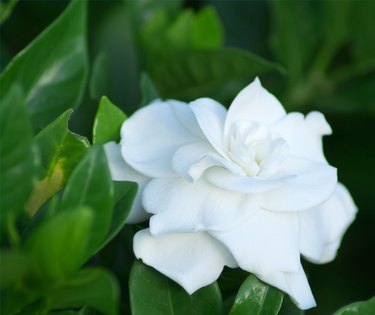
Gardenia plants (Gardenia jasminoides) are prized for their distinctive flowers, heavenly smell and deep green leaves. Wondering how to make gardenias bloom all year? Although they won't give you non-stop blooms all year long, it is possible to see a second round or multiple flushes of flowers during the growing season, depending on the care you give your plants and where your garden is located. Note that they grow best in USDA plant hardiness zones 8 through 11, but some cultivars and even species plants can survive in zone 7 if they are a hardy variety.
How Gardenias Can Thrive
Video of the Day
These popular ornamental shrubs grow from 3 to 8 feet, and they can spread just as wide. The waxy white flowers of a gardenia can be single or double, and measure about 2 to 4 inches in diameter.
Video of the Day
Fall is the best time to plant gardenias, and they prefer areas with morning sun and afternoon shade. They also do well in containers, and they do not like it when their roots are disturbed. Gardenias do better when planted on moist, well-draining soils that are acidic with a pH of less than 6. Before planting, incorporate organic matter such as compost into the soil.
Mulch your gardenia plants with a 2- to 3-inch-deep layer of ground bark or compost and fertilize in the spring after the threat of frost has passed. Use a well-balanced, extended-release fertilizer for acid-loving plants and repeat this process six weeks later.
You can also fertilize your gardenias in the spring and early summer with complete, acid-forming organic fertilizer mixes. Never fertilize gardenia plants in the fall, since they are cold-sensitive, and stimulating new growth is not a good idea during that season.
Caring for Your Gardenias
These bushes have to be watered weekly and more often if it is extremely hot outside. Check the soil for dryness, even when it is in full bloom. Give them around 1 inch of water, adding more if the roots dry out; be sure not to flood them, though. Pour the water directly onto the soil instead of spraying the foliage for the best results.
It is not necessary to prune gardenias after their long bloom season, but if your shrub needs pruning it's best to do this right after it finishes flowering. If you wait too late in the year, you'll be removing flower buds from the "old growth" that will flower next season. If, however, your shrub doesn't need pruning, you may be rewarded with a second round of blooms later in the season.
These plants can become very high and wide, so you may want to keep the size more manageable. Use sharp shears to ensure clean cuts, otherwise, if you make jagged cuts, that could lead to disease. Removing wilting flowers, dead wood and soft branches will also keep your gardenia looking healthy and well.
Getting Year-Round Flowers
The best way to encourage gardenias to bloom throughout the year is to trick them into thinking that it is always spring. They thrive in consistently warm and humid environments, so you may want to keep yours in a container and bring it inside during the colder months. Keep it in a spot that gets the proper amount of sunlight and keep the temperature between 65 and 70 degrees Fahrenheit in the daytime and 55 and 65 F at night.
Don't forget to fertilize your gardenia on a regular schedule. Commercial, 15-5-15 water-soluble flowering shrub fertilizers should be applied once every two weeks. To encourage more blooms, swap that fertilizer out with an acid-based liquid gardenia fertilizer once every three months. And remember, water your gardenia after you fertilize it, every time.